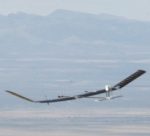Airbus Defence and Space says the solar powered Zephyr 7 High Altitude Pseudo-Satellite (HAPS) has just completed its most demanding mission so far.
We first covered the Zephyr back in 2010 – since that time the craft has evolved and the Zephyr system was sold to EADS Astrium (now part of Airbus) in March 2013.
In its most recent test, the Zephyr 7 successfully completed 11 days of non-stop flight in winter weather conditions with a new primary payload.
Solar power collected during the day charges a lithium-sulphur battery in the Zephyr 7 that is used to power the flight during darkness. As this test was conducted during winter, sun hours were shorter and general weather conditions harsher; making the test all the more challenging.
“During this most recent flight of the Airbus Zephyr, we successfully demonstrated a number of advancements that are critical to achieving the operational readiness of the technology and that increase its operational value for our customers,” said Jens Federhen, Head of the Airbus HAPS programme. “We have furthermore reached an important milestone in our regulatory roadmap.”
The test also marked the first time satellite communications had been used to control and monitor the aircraft.
“The use of the SatCom link to control the aircraft beyond line of sight of the ground station is another critical aspect that we needed to test to move towards a pseudo-satellite form of operation where the Zephyrs can be controlled across the world from a central control station,” said Mr. Federhen.
The Zephyr 7 has a 22.5 m wingspan and is powered by 2 × 450W Newcastle University developed custom permanent-magnet synchronous motors. It can carry a payload of 2.5kg and fully loaded, weighs approximately 53 kilograms. The craft has a cruising speed of 30 knots. Zephyr 8 is currently being developed and it will have an even longer wingspan.
Airbus Defence and Space is a division of Airbus Group. It employs around 40,000 people and generates revenues of approximately AUD $19.7 billion per year.













































